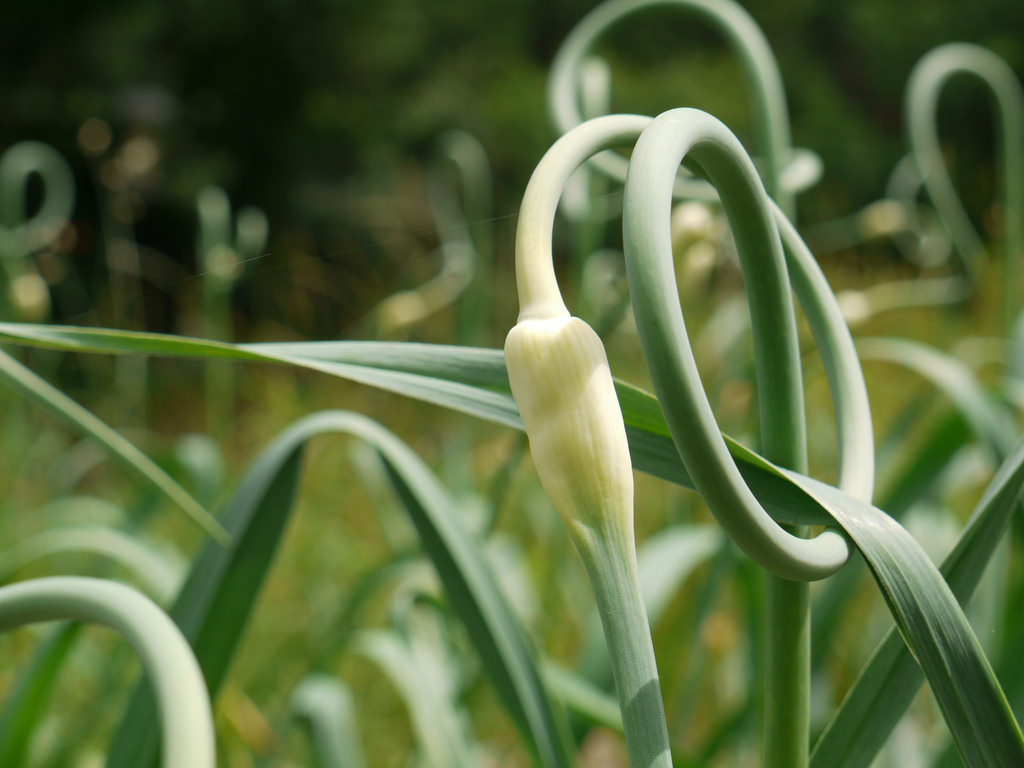I once took a train from Beijing to Siberia. We left the station early, gliding behind factories where thousands of people did synchronized tai chi before work. Soon we picked up speed, heading north toward Mongolia and beyond. I decided to find the dining car and have some breakfast.
There was no menu. They handed you food. My plate contained stir-fried pork and some kind of vegetable in a brown sauce. With rice, of course. As we escaped the outskirts of Beijing, more and more of the landscape became farmland. I figured there was garlic out there, as China produces more than any other country. And I knew from my plate that the scapes were up in northern China.
Garlic is my favorite crop to grow. If you plant enough you can eat it every day. And out in the field there is never a dull moment. The plants are in the ground from fall until summer, leaving a short window between harvest and planting. And now, with the solstice upon us, the garlic harvest begins, in the form of bunches of green, glorious, curly scapes.
These whimsical flowering stalks can act as spice, vegetable, edible skewer, or a decorative centerpiece. Cooked whole, they resemble spears of coiled asparagus, a shape that is tricky to dunk one into some sauce and wrangle into your mouth with any dignity. So rather than making scapes the star of a meal, I usually chop them into bite-sized pieces if I want the vegetable, or mince it if I want the spice. As with all garlic, cooking will soften the flavor of a scape.
I still have a handful of bulbs left from last year’s harvest. They are soft, with green shoots in the middle. I may not get to them now that I have new scapes to work with.
Growers pick the scapes so the plant will divert all of its energy into the growing bulb. Like castrating a steer, but with more chlorophyl. Unharvested, the scape will curl around twice, like a cartoon pig’s tail. And then, over a period of weeks, it will uncurl, stand up tall, and bloom into a purple flower shaped like an exploding firework. If you have some garlic in the ground, it’s worth letting a few plants flower just for the beautiful spectacle.
But just a few. Harvest the rest, because big bulbs are where it’s at. You can snap or snip them, but I prefer to harvest scapes the way you’d pull a blade of grass to chew. Tug with sustained, gentle pressure until you hear the stalk snap off somewhere in the plant. The deeper inside the plant that it breaks, the more tender and juicy the end will be. Deeper breaks will emerge with a slurp, which is appropriate, as the deepest parts are as tender as sushi.
The farmers markets will be full of scapes in the coming weeks. When shopping, the most important thing to look at is the broken end of the scape. If harvested young, and via pulling, the end will be appropriately tender. But if the scape was allowed to curl around once or twice, the cut end may very well be woody, and will have to be trimmed before it can be used, as with asparagus.
With scapes in hand, the possibilities are endless, as with garlic bulbs. It’s spicy when raw, but not as feisty as a clove, which allows you to munch on a scape along with something hearty like hard cheese and or sausage, or smoked Copper River sockeye belly if you have friends like I do. Cooked, scapes are sweet and mellow, without the bitterness a clove can deliver. Many a great meal has started with chopped scapes in a pan with oil, butter or bacon. It could be fried rice, fried eggs, frittata. Use a blender to make scape pesto, with olive oil, cheese and nuts. It’s garlic, so use it every day, in every savory meal.
Stir-fried scapes with pork
This dish can be served vegetarian-style by simply skipping the pork.
Serves 4
½ pound pork, cut into slices no more than ½-inch thick. Don’t trim the fat. You can use bacon.
1 bunch of scapes, with the tips trimmed off and, if necessary, woody ends cut off the bases, chopped into sections of an inch or less.
Sauce ingredients
1 tablespoon each soy sauce, oyster sauce, rice vinegar
1 teaspoon each fish sauce, hoisin sauce, hot sauce, toasted sesame oil, brown sugar
¼ teaspoon black pepper
¼ onion, sliced and teased apart
2 cloves garlic, minced
1 cubic inch ginger, peeled and sliced
In a medium-sized bowl, combine the sauce ingredients.
Heat a pan on medium/high heat and brown the pork, stirring often. When it’s well cooked and delicious looking, add the scapes. Stir-fry for 2-5 minutes, then add the sauce. Stir it in and bring to a simmer. Serve with rice.

